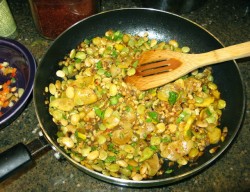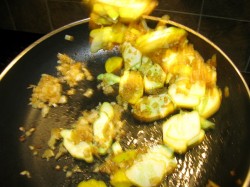Meatless Monday: Three Sisters Succotash
Succotash is one of those dishes that sounds like a joke. You know, like when Sylvester says, “Thsufferin’ thsuccotasth.” It just doesn’t sound like anything that anyone would really eat.
But yes, people do eat it and it is very good.
But where did it get that outlandish name?
It isn’t outlandish at all–I mean really, we European descendant’s languages are the ones that are outlandish to this continent if you look at it from a historical perspective. Succotash, which is a Native American dish, came from the Narragansett word, “msÃckquatash,” which means, “boiled corn.” But it doesn’t denote just boiled corn–it is corn and lima beans, another native food, boiled together. (Often boiled together in a tightly woven basket–one that is so finely wrought that it could hold water. Of course, because baskets cannot survive the direct heat of the fire, the food was cooked by heating clean stones in a fire until they were red-hot. Then, using tongs, the stones were lifted and dropped in the basket which was filled with water, corn and beans. When the stones cooled too much to heat the water, they were fished out and new ones were dropped in. Ingenious, yes?)
The original dish was seasoned with sea salt, and fat rendered from a bear or beaver, but after the Europeans came and brought pigs to the New World, Native Americans began using salt pork or bacon to season the dish. I have seen versions of the recipe that use wild onions and ramps to season the vegetables as well. When settlers took up cooking it, bacon or salt pork were almost universally used in the pot, often with some onions.
Later, during the Depression, when succotash went from being a historical traditional dish at Thanksgiving to being a staple food (because it was a meatless or mostly meatless dish made of inexpensive ingredients that were filling, tasty and nutritious) bell peppers and tomatoes were often added to the recipe.
My Grandma made succotash all the time, as did my Mom and I like it, but I think that was because they both cooked it with a generous dollup of bacon drippings in it. Bacon makes anything good. I am convinced that you could put it on nearly anything and turn it into a revelation, that is, if you are not inclined toward vegetarianism, are Muslim or a Jew who keeps kosher. Then, bacon isn’t so much of an attraction, but to the rest of us–it is nearly irresistible.
But, if I am going to present a vegetarian version of succotash and I want it to still be full flavored as if it were cooked with bacon–I don’t want it to be a pale, pallid, boring combination of beans and corn.
So, this version, which is sauteed in olive oil and simmered in vegetable stock, is flavored with deeply caramelized onions, garlic, sweet and hot peppers, cumin and smoked Spanish paprika.
I also added baby pattypan squash–the third in the triumvirate of staple foods among the agriculturally based northeastern Native Americans which were poetically called, “The Three Sisters.” Corn, squash and climbing beans were planted together in small plots close to villages in forest clearings; the corn rose tall like great green columns, with beans twining up their stalks, while the squash vines sprawled on the ground, shading the roots of both the beans and corn and also shading the soil enough that weed seeds could not germinate. The roots of the bean plants, furthermore, fixed nitrogen from the atmosphere into the soil–a nutrient which corn takes up from the soil in abundance. This interdependent system of agriculture is now called companion planting.
Not only do the Three Sisters benefit from being grown together, I think they benefit from being cooked together. If you do it right and don’t just boil everything to mush without any other flavoring. All three vegetables are sweet, but with different aromas and textures, so they work together perfectly.
Now we come to the drawback of succotash–shelling the lima beans.
You can cheat and use frozen limas, but I prefer the flavor of locally grown fresh limas. But, that means I need to shell the critters, and after years of shelling bushel after bushel of them at Grandma’s farm so she could freeze them–well, let’s just say my thumbs are still traumatized.
See, lima bean pods are really, really tough and leathery. You can’t just pop off the ends and peel back the string and have the pod pop open the way it will do with green beans. Oh, no, that would be too simple. The way we used to shell them when I was a kid was the adults would use a penknife to cut the end off the pod and then pull the string down. Then, their thumbs would scrape the beans into baskets and pots to be blanched and packed into plastic bags and sealed before being stacked in the freezer.
Until I was about eight or nine, I was only allowed to tear the bean pods off of the uprooted plants that lay in the center of our circle. These I would toss into the laps of the adults which were spread with dishtowels, where piles of pods had already been deposited. At each adult’s feet were baskets and pots to hold the beans. When those filled, I carried them and emptied the pretty pale green and creamy white beans into the huge speckled black enamel pot next to Grandma’s rocking chair.
Then, I would take the empty pods and load them and the uprooted and denuded plants into a bushel basket which I would drag to the cow pasture and empty there so the cows could eat their fill of the fresh green goodness. When we had hogs, I would take a basket’s worth to them, too, and chickens got an armload of the plants–chickens really love the taste of legumes like clover, bean plants and pea shoots.
When I was either eight or nine–I can’t remember which–I was allowed to use my brand new pocketknife to actually shell beans like everyone else while a younger cousin got my old job.
I liked the old job better. Even using a knife, the lima bean pods eventually caused blisters to rise on your thumb and made your joints ache. When Mom, Uncle John and Grandpa complained about how bad lima beans are, they were not bloody well kidding–they are beans that really make you work to obtain the delicious calories they contain!
Now, the truth is, shelling enough lima beans for dinner isn’t bad. They don’t raise blisters until you have done about a half bushel or so. And now that I have grown up and have really strong hands, I have come up with a new method of opening lima pods that doesn’t include a knife. I guess this would only work with really strong hands–try it and see if it works for you.
Hold the lima bean pod like I am in the photo above, on edge, and press down with your thumb really hard on the top edge. Usually, it will pop open at the top and you can pry the pod open the rest of the way and scrape the beans out with pretty minimal effort and no real danger of stabbing yourself in the thumb with a small, sharp knife. (Yeah, I did that when I was a kid.)
Kat helped me scrape the beans from the pods, and when we were done, she carried the pot of pods to the kitchen and down the front steps where we tossed them into the woods for the deer to eat.
I do wish we had cows, goats and chickens to eat them instead, but the City of Athens frowns the keeping of livestock in city limits.
But I can dream, can’t I?
Anyway, here is my way of making succotash–and it isn’t long suffering at all.
You can eat it as is with a batch of cornbread and a salad for dinner, or you can use it to fill enchiladas or tamales.
Three Sisters Succotash
Ingredients:
3 tablespoons olive oil
1 cup finely diced onions
1 teaspoon salt
2 tablespoons fresh, minced garlic
2 tablespoons finely diced sweet bell pepper (red is best, but orange or yellow are good, too.)
minced fresh chili (optional)
1 cup thinly sliced baby summer squash (the younger squashes have less water and more flavor)
1/2 teaspoon ground cumin
1 teaspoon Aleppo pepper flakes (optional)
1 teaspoon smoked Spanish paprika
2-3 cobs of either fresh or leftover grilled corn on the cob, kernels cut off
2 1/2 cups fresh, shelled lima beans
1-2 cups vegetable stock or broth
salt and pepper to taste
1/2 cup finely chopped cilantro leaves
2 tablespoons finely diced sweet bell pepper for garnish (it is really pretty if you can use different colors)
Method:
Heat the olive oil in a saute pan for about thirty seconds. Add the onion and sprinkle them with salt. Cook, stirring, until the onions are a nice dark golden color. Add the garlic, bell pepper and chili (if you are using it) and cook for another couple of minutes, until everything is fragrant.
Add the squash slices and cook, stirring, until the squash takes on some golden color. Add the spices–cumin, Aleppo pepper and paprika, and the corn, and cook, stirring for another minute or two.
Add the beans and cook, stirring for a minute, just to get some of the caramelized flavor into the beans.
Then, add the vegetable stock or broth and turn down the heat. Cover and simmer until the beans are as tender as you want them–I like them fully tender for this dish. When they are done, open the lid and boil off most of the liquid, leaving only the caramelized goodness of the vegetables, all of which will have taken on a golden brownish hue.
Add salt and pepper to taste and stir in the cilantro leaves and the fresh, uncooked bell pepper.
Serve immediately.
5 Comments
RSS feed for comments on this post.
Sorry, the comment form is closed at this time.
Powered by WordPress. Graphics by Zak Kramer.
Design update by Daniel Trout.
Entries and comments feeds.







Yum!
Comment by Grace — August 24, 2009 #
Would you like to exchange links on each other’s websites. We sell Support Your Local Farmer T-Shirts here in Concord, NH. It is a small business run out of the home to save on overhead.
Our farm website is lewisfarmnh@comcast.net
Thank you,
Martha Lewis Chase
Harry A. Lewis
Lewis Farm
Silk Farm Road
Concord, NH
Comment by Martha Chase — August 24, 2009 #
Lovely! I do like succotash, although I’m not an enormous fan of lima beans, which I only just realised are called broad beans in my home country. I sub edamame instead which seem a little greener and less mealy, although I guess I ought to try fresh!
Smoked paprika really is wonderful for adding that smoky hint for a vegetarian!
Comment by jennywenny — August 24, 2009 #
You were not kidding about the lima beans. I have not shelled them since I was a kid… and I think I did not shell tons at a time then. Don’t know if I will ever make the requisite 2 1/2 cups….
Comment by Laura — August 25, 2009 #
Just as an anecdata point, I’m vegetarian now, but I never liked bacon even when I wasn’t and wasn’t intending to be. Thus, I’m thrilled at the idea of tasty vegetarian succotash. 🙂
Comment by Alexis — August 25, 2009 #